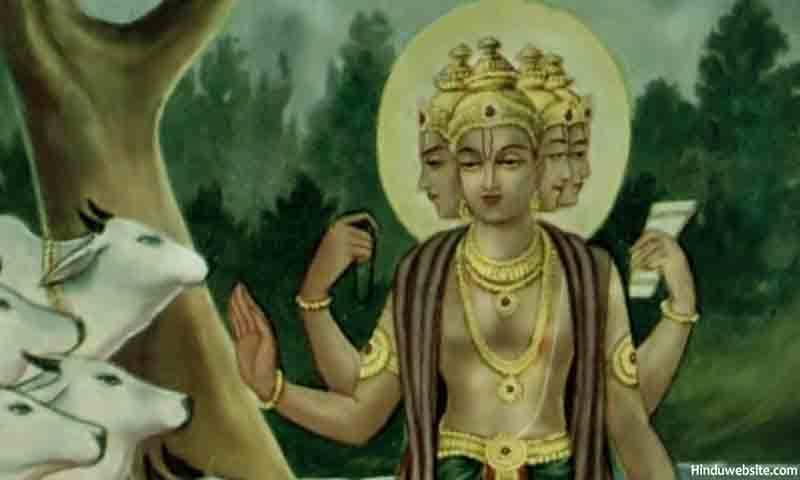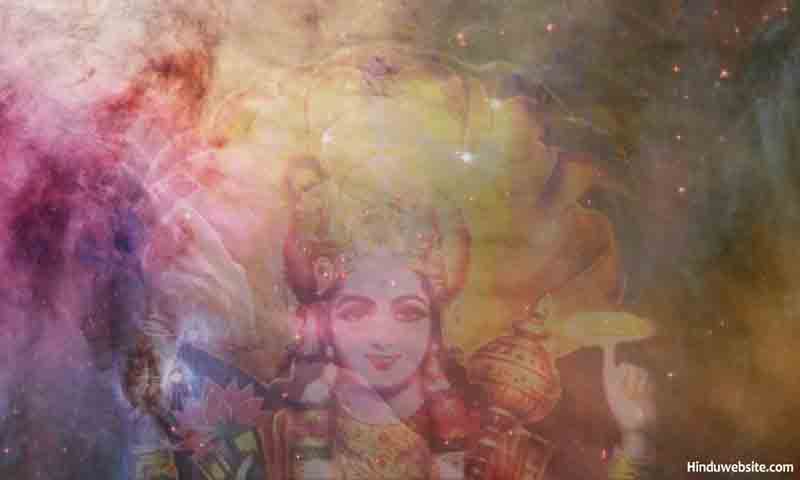
The Five Duties of God or Isvara in Hinduism

The five forms of Isvara refer to his five main functions
Brahman is the highest, infinite and indestructible God of Hinduism. Perhaps, the word God or Lord in reference to Brahman is a misnomer because Brahman is not an entity. In the Upanishads, he is described as That (Tat), denoting his incorporeal state. “That” refers to the highest, the best and the most exalted and immutable state, reality or all the greatness (brihat tattva) one can find in the infinity of existence. The entity which arises from that infinite existence in the beginning of creation is Isvara. He possesses the purest aspects or the exalted state or greatness of That. We call him God or the Lord. He is the purest, universal Being with names and forms, who is described as the purest reflection of Brahman in the infinity of Nature, possessing his purity, will, power, consciousness and bliss (sat-chit-ananda).
All the gods and goddesses of Hindu pantheon arise from him. He is also the creator and sustainer of all worlds and beings. In the Puranas, the infinity of existence is compared to the ocean and Isvara to Para Brahma, Maha Vishnu, Sada Shiva, Maheswara, Narayana, and so on. He is also known as Purusha, the Cosmic Being, who along with Prakriti or Shakti, acting as his dynamic, material force, participates in creation. Prakriti or Shakti is his dynamic half. They are symbolized in the Puranas as Ardhanariswara, the Isvara (Shiva) who is half Purusha and half Prakriti. As the lord of the universe, Isvara has numerous functions. Since Shakti is his dynamic half, these functions are also carried out by Nature (Prakriti) or Primal force (Shakti).
Truly, all actions, functions and movements arise from Isvara. He is the source of all actions and duties, which he performs either directly as himself or indirectly through his numerous manifestations. We can group them into five main categories namely creation, preservation, suppression, expression and destruction. We too perform the same functions in our lives but in a limited way. All the actions which we perform in our lives can be grouped into one or more of them. Our world is created and sustained by them. Life exists because of them. Continuity of life upon earth is ensured because of them. Because of them only, we experience movement of time, the modifications of Nature and the ebb and flow of life. The five main functions of Purusha and Prakriti are described below.
Creation
Creation means coming into existence of something from something. That something may be a material, object, state, condition, movement, cause, effect, reality, thought, idea or action, either acting alone or in combination with others. Creation may arise from natural causes or willful causes or a combination of factors, through a combination of processes such as transformation, suppression, projection, reflection or superimposition. In Hinduism, we believe that Isvara, the manifested Brahman, is the ultimate and essential cause of all creation, and Nature or the primordial force as the material cause. The creator god Brahma manifests from them in the beginning of creation and creates all the worlds and beings according to the will of Isvara and with the help of Shakti, the primal force. Although we are created beings, we are creators in our own right, since we perform many creative functions both physically and mentally to ensure our continuity and survival. Creation is not a one-time effort. It is a continuous process. Time plays an important role, since causes and effects are bound to time and things manifest in their own time.
 Brahma represents the creative functions of Isvara
Brahma represents the creative functions of Isvara
Preservation
Anything which comes into existence has to continue for the duration of its assigned time to justify the reason for which it came into existence. Things exist when all the causes and forces which work upon it (for or against) are in balance. When that balance is lost, things disappear or undergo change or cease to be what they originally are. There is a hidden balance in all things that manifest in creation. We believe that balancing power to be God. He ensures the order and regularity of the worlds by keeping chaos under control. When that control is lost, we believe he personally incarnates upon earth to restore it. He promotes dharma and protects the good and the auspicious from evil. Isvara engages in preservation as nourisher, supporter, provider, upholder, protector, controller and so on. We too perform many functions to ensure the order and regularity of our lives, and protect our minds and bodies from external and internal threats. The longing for life is strong in us. Therefore, we strive for peace, happiness and our material and spiritual wellbeing by our own actions or with the help of gods. We uphold what is good for us and try to avoid evil thoughts and influences which are destructive and harmful.
 Vishnu is worshipped as the preserver who protects and upholds
Dharma
Vishnu is worshipped as the preserver who protects and upholds
Dharma
Suppression
Existence has both visible and invisible aspects. Some truths are self-evident, but many become known only after study, exploration, thinking, discernment and analysis. Even scientifically, we cannot fathom all the mysteries of the universe or our own minds and bodies. In Hinduism we believe that Isvara is a concealer who suppresses truths of existence as a part of his duties. For example, he suppresses the truth of himself and remains hidden in everything, so that he becomes self-evident according to our knowledge, discernment and spiritual progress. He also casts the net of Maya to keep beings deluded and ignorant of their spiritual nature. In life, we too engage in concealment. Everyone has a hidden and an unknown aspect, which is difficult to know or unravel. A part of it remains forever hidden from oneself since everything cannot be brought out into wakeful consciousness. People engage in concealment or suppression when they speak untruths, hide truths and their true intentions, hold secrets, obfuscate facts, wear masks or engage in pretentious behavior. We also keep many thoughts to ourselves for various reasons. This is perfectly normal and human. According to Hindu ethical code of conduct one shall conceal truth if it is going to hurt or harm someone.
 Isvara as the concealer remains hidden in creation
Isvara as the concealer remains hidden in creation
Revelation
Revelation may arise from inquiry, study, learning, knowing, observing, intuition or divine intervention. Isvara is the ultimate revealer. He reveals the knowledge of liberation or the Self to his devotees according to their faith, devotion, purity and surrender. In each epoch, he manifests upon earth in different forms and reveals sacred knowledge. Therefore, he is also known as the world teacher. He also reveals the sacred knowledge of the scriptures and the transcendental truths that are beyond our minds and senses. Fate, karma and Time also play an important role. Suffering is also a teacher. People learn important lessons from their failures and sinful actions. Sometimes, we too open up and reveal truths about ourselves to those we trust. Sometimes, others may come to know about us through our actions and intentions. In Nature, many things remain in a latent state, and reveal themselves when their time is due. Revelation and concealment are ancillary to preservation. Hence, they are often excluded from the main functions of Isvara.
 Isvara reveals himself according to our spiritual purity and
development
Isvara reveals himself according to our spiritual purity and
development
Destruction
Hinduism holds that creation is both cyclical and repetitive. At the end of each cycle, it comes to an end through dissolution, withdrawal or destruction. The destructive power of Nature is self-evident. Destruction in Nature happens continuously as a part of its renewal and regeneration. Things perish or degenerate with time. Hence, Time (kala) is considered a destructive force of God and an aspect of Nature (kali). In the Hindu Pantheon, Shiva is considered the lord of destruction. He has several other names which point to his role as the destroyer. Destruction has both positive and negative aspects. Destruction of negative qualities, evil powers, sins, ignorance, attachments, delusion, etc., lead to peace, happiness and liberation, while destruction of their opposites lead to suffering and spiritual downfall. As human beings, we too engage in many destructive actions, which may lead to our spiritual progress and material wellbeing or to our downfall depending upon what types of destructive actions we perform.
 Kali, the dynamic force of Kala, personifies Isvara's destructive
aspect.
Kali, the dynamic force of Kala, personifies Isvara's destructive
aspect.
Conclusion
Some descriptions mention only three functions rather than five, creation, preservation and destruction, as symbolized by the triple gods namely Brahma, Vishnu and Shiva. They regard suppression and expression as the associate functions of creation. One may also see that it is difficult to separate these functions, since they are interrelated and can be complimentary. For example, creation may involve destruction; preservation may involve suppression and destruction may involve preservation. In other words, they may be consequential, incidental or correlated. The reality is that our lives and existence are shaped by them. Every action which we perform in our lives can be grouped under one or more of these five categories. By understanding them and their implication and importance to our lives, we can shape our lives and destines.
Suggestions for Further Reading
- The Symbolism of Snakes and Serpents in Hinduism
- Ten Distinguishing Features Of Hinduism
- Ten Reasons Why You Should Worship Shiva
- The River Sutra - Lessons From the River
- The Ten Main Duties (dharmas) in Hinduism
- The Ten Manifestations Of Sattva in Hinduism
- The 12 Manifestations of Brahman, the Supreme God of Hinduism
- Ten Teachings of the Buddha From the Dhammapada
- The Meaning And Significance Of Swastika In Hinduism
- What is Prana? The Five Types of Breath
- Hinduism and the God of Death
- Om, Aum, Pranava or Nada in Mantra and Yoga Traditions
- Wealth and Duty in Hinduism
- Hindu Gods - Lord Ganesha
- Symbolism and Significance of the Descent Of Ganga
- Symbolism of Ganga As the Purifier and Liberator
- The Meaning and Significance of Heart in Hinduism
- The Origin and Significance of the Epic Mahabharata
- Yin and Yang, and the Hindu Connection
- Symbolism in the Story of Sagar Manthan, the Churning of The Ocean
- The Symbolic Significance of Puja Or Worship In Hinduism
- Essays On Dharma
- Esoteric Mystic Hinduism
- Introduction to Hinduism
- Hindu Way of Life
- Essays On Karma
- Hindu Rites and Rituals
- The Origin of The Sanskrit Language
- Symbolism in Hinduism
- Essays on The Upanishads
- Concepts of Hinduism
- Essays on Atman
- Hindu Festivals
- Spiritual Practice
- Right Living
- Yoga of Sorrow
- Happiness
- Mental Health
- Concepts of Buddhism
- General Essays
Image Credits: The images used in this articles are either in public domain or licensed under various Creative Commons Attribution-Share Alike Generic licenses by Wikipedia, Himalayan Academy Publications and Wikimedia. This article is copyright Hinduwebsite.com and should not be reproduced in any format without prior written permission.